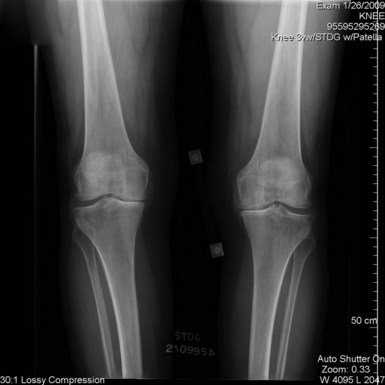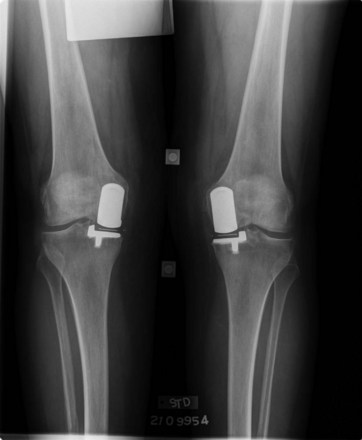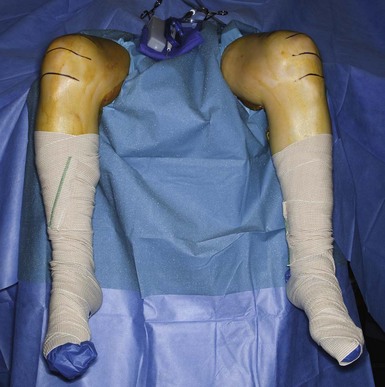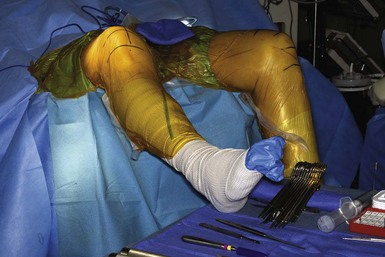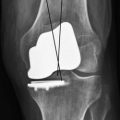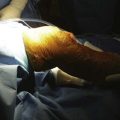CHAPTER 31 Bilateral Unicompartmental Knee Arthroplasty
Introduction
Knee arthroplasty procedures have become a reliable, long-term solution for disabling knee pain, and have begun to be used in an increasingly younger patient population. The number of unicompartmental arthroplasties of the knee has increased at a rate of 32.5% annually over the last few years.1,2 This procedure has emerged as an attractive alternative to total knee arthroplasty for many arthroplasty surgeons, when used in the proper surgical setting, as it spares more bone, is associated with better knee kinematics, provides a more rapid postoperative recovery, and potentially allows for an easier revision if needed.3–7 Bilateral unicompartmental arthroplasty is an alternative in the patient with symptomatic bilateral knee arthritis isolated to one compartment of the tibiofemoral articulation (Figs. 31–1 and 31–2). This chapter discusses the indications and outcomes of bilateral unicompartmental arthroplasty as well as the surrounding controversies limiting its widespread use, followed by the authors’ preferred method of treatment.
Rationale
There is a paucity of data on bilateral unicompartmental arthroplasties; therefore, the data on bilateral total knee arthroplasties (TKAs) could be extrapolated to the unicompartmental discussion, although clearly the morbidity and risks associated with TKA are quite different from those of unicompartmental arthroplasty. There are a myriad of studies investigating the safety of bilateral TKA. Although some authors have maintained that patient selection is quintessential to avoiding a higher complication rate, many other authors have reported an increased risk of cardiac and pulmonary complications as well as an increased postoperative 30-day mortality in the simultaneous bilateral total knee setting.8–13 In a recent meta-analysis looking at the safety of bilateral TKA, the prevalences of pulmonary embolism (PE), cardiac complications, and mortality were higher after simultaneous bilateral total knee replacement.11 In light of these known complications, some authors have stressed the importance of mitigating perioperative risk by screening for preexisting cardiac or pulmonary disease prior to proceeding with bilateral TKA.9,12–17
Although there are increased risks of complications associated with simultaneous bilateral TKA, there are certain advantages to undergoing both knee replacements under one anesthetic. Obviously, there is only one anesthetic risk and one hospital stay, which translate into a shorter cumulative stay and less overall cost. In addition, the patient undergoes symmetric rehabilitation, which may explain the better functional outcomes reported with simultaneous bilateral TKAs.11-13,18-22 Zeni et al.22 evaluated the functional outcomes of patients undergoing simultaneous bilateral TKA compared to those undergoing unilateral TKA and a healthy control group. These patients were matched for sex, age, and body mass index, and were observed prospectively for 2 years. Subjects in both surgical groups showed significant improvement in knee outcome scores, Short Form-36 physical component scores, timed up-and-go test, and stair-climbing tasks. No significant differences were seen in final outcomes between surgical groups. The authors of that study concluded that subjects medically appropriate for bilateral TKA should be given this option.
The cost-effectiveness of bilateral unicompartmental arthroplasty has not been reported in the literature, but it has been reported for bilateral TKA as well as unicompartmental arthroplasty on a single side.23 Reuben et al.21 used a hospital-based computer system to compare the inpatient costs of performing bilateral simultaneous sequential, staged, and unilateral TKAs. Bilateral simultaneous sequential TKA was 36% less costly than bilateral staged TKA. Prosthetic costs range between 28% and 43% of the total costs of hospitalization. There was a significant correlation between hospital length of stay, morbidity, and total costs, but no correlation with patient age and gender except in the unilateral knee surgery patients. The authors concluded that bilateral simultaneous sequential TKA can save more than $10,000 for each total knee replacement patient.21 With the idea of looking specifically at overall cost of bilateral unicompartmental arthroplasties at the Mayo Clinic, we reviewed 20 patients who underwent bilateral unicompartmental arthroplasty on the same day as well as in a staged fashion and compared the two groups. The increase in overall costs for the bilateral unicompartmental arthroplasty performed in a staged fashion was 37% when compared to simultaneous bilateral UKA. For the staged procedure, the cumulative operating room costs increased 20%, hospital and nursing costs 28%, and the surgeon reimbursement was increased 25% when compared to the simultaneous bilateral knee group. However, the hospital net revenue was 39% more for the staged when compared to the simultaneous procedure.
Outcomes
Very little has been published reporting the outcome of patients who have undergone bilateral unicompartmental arthroplasties. The only available study in the published literature to date compares the immediate postoperative complications of single- versus two-stage bilateral unicompartmental knee replacement.24 Chan et al. provided this retrospective look at the major complications occurring after simultaneous and staged bilateral unicompartmental arthroplasties by comparing 159 patients (318 knees) treated with one-stage and 80 patients (160 knees) treated with two-stage arthroplasty. The bilateral unicompartmental groups were comparable in age and in ASA grade. The major complications they tracked were death, PE, proximal deep vein thrombosis (DVT), and adverse cardiac events within 30 days of surgery. Major complications were seen in 13 patients (8.2%) with one-stage operations but none were encountered in the two-stage group, which reveals a statistically significant difference. The authors of that study concluded that the significantly higher risk of major complications associated with one-stage bilateral unicompartmental knee replacement should make surgeons take caution prior to undertaking such a procedure.
There were several limitations to this study that should be pointed out to the reader. No chemoprophylaxis was used in their protocol, and venous thromboembolism accounted for the majority of the complications. Ten different surgeons performed the cases, and the anesthetic protocol used was local wound infiltration in combination with general anesthesia.24 These differences may not allow for the data to be translated to North America as chemoprophylaxis is routinely used and spinal anesthesia is typically used for anesthesia. At the closed meeting of the Knee Society in 2009, Berend et al. presented a large series of patients undergoing bilateral unicompartmental knee arthroplasty. They compared 141 patients (282 knees) treated with staged partial knee arthroplasty to 35 patients (70 knees) treated with simultaneous partial knee arthroplasty to evaluate perioperative complications and short-term functional outcomes. Patients in the study who underwent simultaneous unicompartmental knee arthroplasty had a significantly shorter cumulative operative time (109 vs. 122 minutes), a shorter cumulative length of stay in the hospital (1.7 vs. 2.5 days), higher Knee Society Functional scores at most recent follow-up (87.9 vs. 72.9), and higher Lower Extremity Activity Scale scores (12.0 vs. 10.2) without a difference in perioperative complications. In the study, the simultaneous cohort was significantly younger and less obese than the staged group, which could account for some of the differences encountered in the study. The lack of difference in perioperative complications is distinctly different from the findings by Chan et al. and is likely due to the disparity in anesthetic protocols and the changes in venous thromboembolism prevention. Berend et al. used a combined spinal and general anesthetic with local wound infiltration, and all of the patients received some form of chemoprophylaxis—either aspirin, low-molecular-weight heparin, or warfarin (Coumadin)—based on preoperative risk stratification.
Authors’ Preferred Methods
The medical risks associated with unicompartmental arthroplasty are likely less than for those patients undergoing TKA. The lesser invasiveness of the operation will likely place patients at less risk of developing pulmonary or cardiac complications after surgery. Lombardi et al.25 have reported the complication rates associated with 1000 unicompartmental arthroplasties, with no patients requiring transfusions or developing cardiac complications, and one patient with a DVT. One could then possibly conclude that the risk of bilateral unicompartmental arthroplasty is likely less than that of bilateral TKA. In light of Chan et al.’s data,24 however, the higher risk of DVT should be discussed with the patients, and those with a history of previous DVTs or PE are likely not good candidates for undergoing bilateral simultaneous unicompartmental arthroplasty. Patients with severe cardiac comorbidities are probably not good candidates either, and in those cases a staged approach might be a better option.
At our institution, patients undergoing bilateral simultaneous unicompartmental arthroplasties are given a multimodal anesthetic protocol.26 The reader is referred to this reference for a complete description of the technique. The patient is placed supine and the legs are draped freely, or if the choice is bilateral mobile-bearing unicompartmental arthroplasty, then the patient is placed in bilateral stirrup leg holders with the extremities hanging over the distal aspect of the operating room table (Fig. 31–3). The table is broken distally to provide positioning for both legs. The surgeon can decide to prep both legs at the time of surgery and perform the arthroplasties in a staggered simultaneous fashion, or both legs can be prepped and draped separately and approached separately. After closure of the first knee, that knee can be extended on a Mayo stand (Fig. 31–4). Intraoperatively, our preference is to not elevate the tourniquet on both knees at the same time. The tourniquet is brought up for the first knee, and once the components are cemented, then the incision is made without tourniquet on the second side, and once the tourniquet has been released on the first side, it is elevated on the second side. An alternative to this technique would be to use the tourniquet only for cementing, and therefore knees could potentially be worked on by two teams simultaneously, taking care again not to cement at the same time. We typically use both chemical and mechanical DVT prophylaxis while the patient is in the hospital. Aspirin, 325 mg by mouth twice daily, is used for 6 weeks unless the patient has a medical comorbidity that requires long-term Coumadin. Mechanical prophylaxis is in the form of thromboembolic disease (TED) stockings and sequential compressive devices, but these are used only while in the hospital. The postoperative rehabilitation protocol is very similar to that used for bilateral TKA. Patients are allowed to weight bear as tolerated routinely. Supine straight leg raises and flexion and extension exercises as tolerated are started on the day of surgery. Bilateral femoral nerve blocks help with postoperative pain but in some cases may hinder rehabilitation, and care must be taken to use knee immobilizers if these blocks are used. Femoral nerve blocks are usually removed 24–36 hours after surgery to allow for a more efficient rehabilitation.
1 Riddle DL, Jiranek WA, McGlynn FJ. Yearly incidence of unicompartmental knee arthroplasty in the United States. J Arthroplasty. 2008;23:408.
2 Kurtz S, Ong K, Lau E, et al. Projections of primary and revision hip and knee arthroplasty in the United States from 2005 to 2030. J Bone Joint Surg [Am]. 2007;89:780.
3 Dudley TE, Gioe TJ, Sinner P, Mehle S, Registry outcomes of unicompartmental knee arthroplasty revisions. Clin Orthop Relat Res, 466, 2008, 1666.
4 Kasodekar VB, Yeo SJ, Othman S. Clinical outcome of unicompartmental knee arthroplasty and influence of alignment on prosthesis survival rate. Singapore Med J. 2006;47:796.
5 Laurencin CT, Zelicof SB, Scott RD, Ewald FC, Unicompartmental versus total knee arthroplasty in the same patient: a comparative study. Clin Orthop Relat Res, 273, 1991, 151.
6 Saito T, Takeuchi R, Yamamoto K, et al. Unicompartmental knee arthroplasty for osteoarthritis of the knee: remaining postoperative flexion contracture affecting overall results. J Arthroplasty. 2003;18:612.
7 Scott RD. Three decades of experience with unicompartmental knee arthroplasty: mistakes made and lessons learned. Orthopedics. 2006;29:829.
8 Leonard L, Williamson DM, Ivory JP, Jennison C. An evaluation of the safety and efficacy of simultaneous bilateral total knee arthroplasty. J Arthroplasty. 2003;18:972.
9 Morrey BF, Adams RA, Ilstrup DM, Bryan RS. Complications and mortality associated with bilateral or unilateral total knee arthroplasty. J Bone Joint Surg [Am]. 1987;69:484.
10 Parvizi J, Sullivan TA, Trousdale RT, Lewallen DG. Thirty-day mortality after total knee arthroplasty. J Bone Joint Surg [Am]. 2001;83:1157.
11 Restrepo C, Parvizi J, Dietrich T, Einhorn TA. Safety of simultaneous bilateral total knee arthroplasty: a meta-analysis. J Bone Joint Surg [Am]. 2007;89:1220.
12 Ritter MA, Harty LD, Davis KE, et al. Simultaneous bilateral, staged bilateral, and unilateral total knee arthroplasty: a survival analysis. J Bone Joint Surg [Am]. 2003;85:1532.
13 Severson EP, Mariani EM, Bourne MH. Bilateral total knee arthroplasty in patients 70 years and older. Orthopedics. 2009;32:316.
14 Borgwardt L, Zerahn B, Bliddal H, et al. Similar clinical outcome after unicompartmental knee arthroplasty using a conventional or accelerated care program: a randomized, controlled study of 40 patients. Acta Orthop. 2009;80:334.
15 Borus T, Thornhill T. Unicompartmental knee arthroplasty. J Am Acad Orthop Surg. 2008;16:9.
16 Bullock DP, Sporer SM, Shirreffs TGJr. Comparison of simultaneous bilateral with unilateral total knee arthroplasty in terms of perioperative complications. J Bone Joint Surg [Am]. 2003;85:1981.
17 Vince KG, Cyran LT. Unicompartmental knee arthroplasty: new indications, more complications? J Arthroplasty. 2004;19(4 Suppl 1):9.
18 Lonner JH, Jasko JG, Bezwada HP, Booth REJr, Morbidity of sequential bilateral revision TKA performed under a single anesthetic. Clin Orthop Relat Res, 464, 2007, 151.
19 Malinzak RA, Ritter MA, Berend ME, et al. Morbidly obese, diabetic, younger, and unilateral joint arthroplasty patients have elevated total joint arthroplasty infection rates. J Arthroplasty. 2009;24(6 Suppl):84.
20 Powell RS, Pulido P, Tuason MS, et al. Bilateral vs unilateral total knee arthroplasty: a patient-based comparison of pain levels and recovery of ambulatory skills. J Arthroplasty. 2006;21:642.
21 Reuben JD, Meyers SJ, Cox DD, et al. Cost comparison between bilateral simultaneous, staged, and unilateral total joint arthroplasty. J Arthroplasty. 1998;13:172.
22 Zeni JAJr, Snyder-Mackler L. Clinical outcomes after simultaneous bilateral total knee arthroplasty comparison to unilateral total knee arthroplasty and healthy controls. J Arthroplasty. 2010;25:541.
23 Soohoo NF, Sharifi H, Kominski G, Lieberman JR. Cost-effectiveness analysis of unicompartmental knee arthroplasty as an alternative to total knee arthroplasty for unicompartmental osteoarthritis. J Bone Joint Surg [Am]. 2006;88:1975.
24 Chan WCW, Musonda P, Cooper AS, et al. One-stage versus two-stage bilateral unicompartmental knee replacement: a comparison of immediate post-operative complications. J Bone Joint Surg [Br]. 2009;91:1305.
25 Lombardi AV, Berend KR, Tucker TL. The incidence and prevention of symptomatic thromboembolic disease following unicompartmental knee arthroplasty. Orthopedics. 2007;30(5 Suppl):41.
26 Hebl JR, Dilger JA, Byer DE, et al. A pre-emptive multimodal pathway featuring peripheral nerve block improves perioperative outcomes after major orthopedic surgery. Reg Anesth Pain Med. 2008;33:510.




